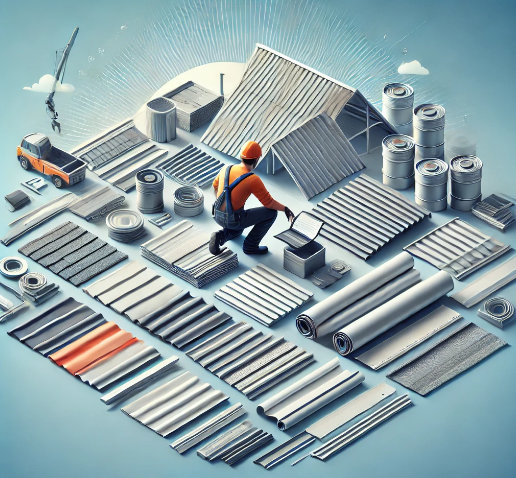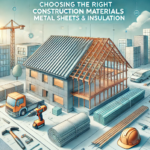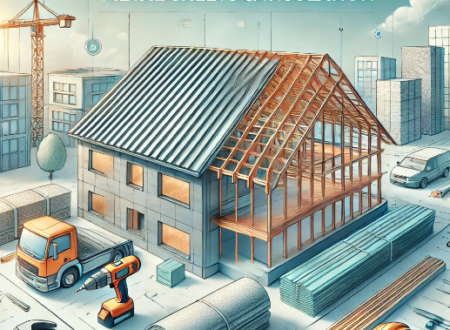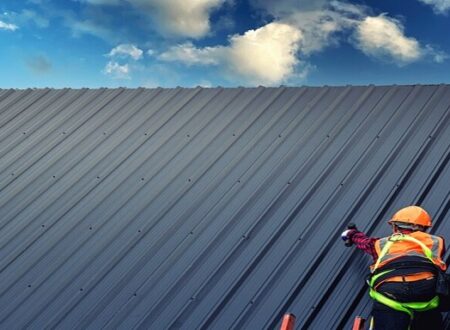It doesn’t have to be challenging to decide which type of metal to use or which roofing product is right for your project. First of all, try to focus on your requirements. If you are in a hurry, do you need something light and portable, or do you require something more robust and solid? Second, consider what kind of roof fits your budget and how long you wish that roof to last. Switching to energy-efficient materials in the long run will be economically rewarding. Also, consider the fire rating and how simple it becomes to put in place.
Exhaustive details such as maintenance and protection from the vagaries of nature cannot be relished if omitted altogether. Check for the products that suit your climate conditions. It is essential to take the correct measurements of your roof and always ensure you add a little more of the corrugated roofing sheets on top. Do not join two dissimilar materials. Finally, make your decision based on prices, guarantees, and reliability. With these tips, you can be sure to make the right decision regarding the roofing materials that will best suit a lasting and efficient roof.
Know Your Project Needs
Every project is different, so you need to know your requirements. Start by thinking about the type of building. Is it a home, a garage, or maybe a barn? Each structure has unique needs. For example, homes often need materials that look great and last long. Meanwhile, barns need strong, weather-resistant materials.
Next, consider the roof’s shape. Is it flat or sloped? Some materials, like metal roofing sheets, work well on various roof types. Others, like tiles, might need a steeper slope.
Also, think about your climate. If you live in a rainy or snowy area, choose materials like metal or asphalt shingles that can handle moisture. Hot and sunny climates might require energy-efficient roofing options.
By understanding your project’s specific needs, you’ll make better choices for durable and affordable roofing materials.
Explore Your Roofing Material Options
Choosing the right roofing material is essential for durability, energy efficiency, and style. From metal to shingles, each option offers unique benefits. Explore your choices to find the perfect fit for your home or project needs.
Metal Roofing
Metal roofing is durable, long-lasting, and versatile. Common types include:
- Steel: Strong, affordable, and available in various finishes. Best for harsh weather conditions.
- Aluminum: Lightweight and rust-resistant, making it ideal for coastal areas.
- Copper: Offers a unique, elegant look and lasts for decades but is costly.
- Zinc: Highly durable and eco-friendly but expensive.
Other Roofing Materials
Asphalt Shingles
Asphalt shingles are a common type of roof. They cost less, are portable, and can be installed easily. Coming in so many designs and colors, they are ideal for most designs in homes at the current age. However, they have a relatively shorter lifespan and are used for fifteen to thirty years.
Clay and Concrete Tiles
These tiles are great for places with a lot of sun and high temperatures. It’s fire resistant, and it possesses a classic Mediterranean appearance. Moreover, they are not the lightest ones, which is probably why they are so durable. You have to ensure that your roof structure can support them.
Slate Roofing
One such material is slate, which is preferred owing to its attractive color and low permeability. It can last over a hundred years, of course. However, it is highly dependent on its maintenance. However, the paneling is costly and durable as it is heavy and easily damaged. Thus, it needs professional installation.
Wood Shingles and Shakes
This roofing is quite fashionable, and it gives a cottage–like appeal to the house. It is manufactured from cedar, redwood, or pine; thus, they are suitable for the natural environment. Of course, wood has its drawbacks: it must be painted or varnished to avoid mold, rotting, or insect intrusion. The final benefit of concrete blocks is that they last longer in dry conditions but are less durable in wet climates.
Synthetic Roofing Materials
They are artificial look-alikes of more costly materials such as slate or timber. These are generally light, strong, and economically priced. Although they may not look as appealing as natural, they are easier to maintain and apply.
Green Roofs
Vegetated roofs are sustainable roofs and act as insulators. They are concerned with vegetation and are preferable to urban settings. Moreover, they require professional installation and maintenance, which puts them in the more expensive category.
Solar Roofing
Solar roofs consist of both a roofing design and solar power production. While they are costly to install, they will save you on your electricity bills in the long run. They are ideal for regions with a warm climate and environmentally friendly homeowners.
Consider Important Factors
Choosing the right roofing material requires more than looks. Think about weight, lifespan, energy efficiency, fire resistance, and installation needs. These factors ensure your roof is durable, safe, and cost-effective for your home or project.
Durability
Another feature considered necessary for selecting materials is the roof’s durability. Your roof has to endure all odds of your regional climate. For example, Find the Best Metal and Roofing Materials to use metal or slate where there are many blizzards or wind gusts. On the other hand, regions that experience generalized heat and sunshine get to enjoy the availability of reflective shingles or tiles. When you pick a hard-wearing material, the beneficiary is not just the structure you put in place but by minimizing repair and replacement work.
Cost
The roofing sheets price, therefore, encompasses the initial and the sustained expenses. For instance, ASPA shingles’ first cost is relatively low compared to slate and metal; however, it will likely wear out faster than the latter. The cost should then be determined by factors such as the durability of each material, the required maintenance frequency, and the energy cost. High costs might seem costly at first glance but end up costing little in repairs or replacement, which is why investing in quality materials is essential.
Appearance
Your roof is also essential as it forms part of the façade of your building. It should blend with the structure’s architectural design to add value regarding its exterior looks. Metal roofing is preferable for a modern-looking home, especially with smooth metallic finishes. For more customary or older-styled homes, slate or wood shingles give the perfect ambiance. It is also necessary to seek the color and texture of every material available and select one that will get you rolling.
Eco-Friendliness
If sustainability interests you, seek an environment-friendly roofing material. Choices, including recycled metal, green roofs, or solar shingles, decrease the harm to the surrounding environment. Moreover, products with high SRI prolong the life of your building construction and make your building cooler, especially when placed in an area that experiences hot days. Selecting environmentally sound products can also provide added benefits such as property appreciation and potential buyers inclined towards green products.
Maintenance
Some of the roofing materials require more maintenance than others do. For instance, metal roofs are more experimental because they require very little maintenance, while wood shingle roofs require checkups and re-treating against rotting or insect pest attacks. Think of how often and for how long you are willing to spend time and money on maintenance and upkeep. Using a low-maintenance material can significantly reduce your time and expenses during the subsequent roof’s use.
Weight
The weight of the roofing material that has been discussed influences the supporting structure and installation convenience. Quantities of metals- lighter metallic substances such as aluminum or steel need lesser support structures than comparatively larger volumes such as copper. Deciding on the correct weight permits reliability and durability rather than affecting the building structure.
Lifespan
Since many users make long-term investments, the lifespan of a material is a considerable factor in determining success. Some types of metal roofs, like Galvanized Pipes and Coils, have a lifespan of 40 to 70 years and are properly maintained. When choosing between materials, corrosion resistance, and durability should be compared to find the material that will give the longest-lasting protection of the structure in terms of appearance.
Energy Efficiency:
Different types of roofing affect energy use in buildings. Some roofs are made of reflective metal that doesn’t allow heat to penetrate, causing cooling costs, while others, such as asphalt, allow heat to penetrate. Consequently, some exciting products like cool roofs or coatings that can reduce heating and cooling requirements and thus reduce energy bills will be embraced.
Fire Resistance:
Fire-protective roofing is fatal for safety. Metals such as steel, aluminum, and copper confer extensive fire protection to buildings from flames or sparks. Selecting nonflammable materials, especially in fire-hazardous zones, will help minimize the losses and add value to your structure and insurance.
Installation Requirements:
Factors that influence your decision include, for example, the level of the installation’s difficulty or the installation time. Such materials as asphalt shingles are relatively simple to work with compared to metal roofing, which would need the input of a roofer and special equipment. Closely coordinate the materials you choose with financial situations, your abilities, time constraints, or extra costs.
Tips for Saving Money
When selecting roofing materials, cost matters. Look for affordable options without sacrificing quality. Consider long-term savings through energy efficiency, DIY installation, or buying in bulk. These tips help you reduce costs while ensuring your roof’s durability and performance.
- Compare Materials: Learn more about metal roofing, including steel, aluminum, and copper, to establish the most suitable price and quality. Sometimes steel is cheaper than the other materials; however, aluminum has weight advantages.
- Consider Long-Term Savings: Aluminum and steel roofs might cost more than traditional roofs initially, but their advantages, like the durability to wear and tear and their energy efficiency, enable lower amounts of money to be spent on maintenance and electricity later. Please do not dismiss it because of the time it will take before others start reaping the benefits.
- Buy in Bulk: If you procure materials for a big project, the overall cost per unit can be reduced when procuring large quantities. See special offers and free samples from metal suppliers in UAE to buy a product in bulk.
- DIY Installation: We can help you complete the roof installation yourself if you possess the necessary expertise. It is often cheaper to hire professionals, but if you believe you can do the work well, it is always advisable to ask for professional-looking installations yourself.
- Look for Discounts and Sales: Many suppliers’ current promotions are seasonal. Purchasing material during off-peak season or a sale is cheaper and can lower your final cost.
- Recycling and Repurposing: If you are replacing your previous roof, reuse or look for old metals to put in the roof. This may help cut disposal expenses and decrease new material costs.
- Negotiate with Contractors: If you hire a contractor for the installation, do not skimp on quotes, and do not shy away from bargaining. Contractors may have a better price for their services during off-seasons to attract business.
Maintenance Tips
To keep your roof in top condition, regular care is key. Simple tasks like cleaning, checking for damage, and addressing issues early can extend your roof’s lifespan. Follow these maintenance tips to protect your investment and avoid costly repairs.
- Regular Inspections: You should inspect your roof at least twice yearly for damage, rust, or other signs, such as loose fasteners. It is almost always cheaper to fix problems as soon as they are noticed than to let them develop into extensive and complicated issues.
- Keep It Clean: Cleared especially of leaves, branches, and dirt as often as possible. This reduces the chances of water accumulating, corroding the body, or causing a leak in the long run.
- Address Rust Promptly: If the aluminum has rust, then remove the rust and apply a rust-preventing compound. Repaint the same color for painted roofs to continue serving their function and look aesthetically good.
- Ensure Proper Drainage: It is recommended to clean gutters and downspouts when they get filled with water often. If your roof drainage is terrible or nonexistent, it can significantly impact your roof’s condition and durability.
- Check Fasteners and Seals: Check screws and tighten up all the loose screws, nuts, and bolts found in the machine. Check for and touch up any areas where the sealant has weakened or eroded to ensure the roof does not leak or allow water to penetrate.
- Trim Surrounding Trees: Swaying branches can rub the metal roof surfaces and cause scratches or dents, apart from creating falls of branches and leaves on the roof. Trees near them should be pruned so as not to cause future nuisances.
- Hire Professionals for Major Repairs: If you have to paint your walls or change a tire or if something serious is wrong with your vehicle, take it to a professional to be safe.
Avoid Common Mistakes
Choosing the right roofing materials can be tricky. Avoid common mistakes like skipping research, ignoring maintenance, or choosing price over quality. By staying informed and planning carefully, you can make the best decision for your roof’s longevity and performance.
- Skipping Research: Using metal for a particular project is not very practical. To avoid mismatch, one should not rush to select materials before getting their facts right on climate, structures, and requirements.
- Ignoring Weight Limits: Lack of understanding of the structural load capacity of your building poses some dangers to people. The thickness of the material used should always weigh with the structure’s design in place.
- Choosing Price Over Quality: Often, individuals choose the most affordable option for construction material; it causes more spending on repairs and replacements.
- Neglecting Fire and Weather Resistance: One of the biggest mistakes is not paying attention to some materials’ fire rating or weather resistance, especially in high-risk areas.
- Improper Installation: Many have installed such systems, leading to leakage, damage, or short product life Span. : Seek help from a professional if you do not understand how the system works.
- Forgetting Maintenance: Many people misunderstand that metal roofs do not require any maintenance at all, which is quite dangerous. This means you keep your roof in the best state and get optimal value for the money you spend on it.
- Not Checking Warranties: Various materials can come with a limited warranty that does not include essential problems. You need to review warranties to ensure they are as per your desires.
FAQs
What is the most durable roofing material?
Metal roofing, especially standing seam steel or aluminum, is among the most durable options. It resists extreme weather, lasts 40–70 years or more, and requires minimal maintenance, making it ideal for long-term protection and performance.
How do I calculate how much material I need?
Measure your roof’s length and width to calculate its square-foot area. Divide the total by the material’s coverage per unit (e.g., shingles, panels), and add 10–15% extra for waste and overlaps.
Can I mix different roofing materials?
Yes, but most of these materials can be accomplished by blending them in a project with strategy. It is important to match one’s weight, durability, and appearance. For instance, metal can be combined with shingles, while some accents can be designed from metal. Seek advice that prevents calamities of structural or aesthetic discrepancies.
What should I look for if I suspect I require a roof replacement?
This includes blisters, buckling, and curling of shingles, dilapidation on metal roofs, stains and discolorations, water stains in the ceilings and walls, and accumulation of granules in the gutters. Roof replacement is required if your roof has lasted for many years or the shingles are already brittle and beyond restoration.
Conclusion
Evaluating and selecting the proper metal or roofing material is easy when you have a plan for it. These characteristics include weight, life expectancy, efficiency, flame resistance, and installation requirements. Some of the mistakes you should best avoid include failure to go for research or selecting products based on their prices rather than quality. In this way, if you remain informed, you can choose durable materials that safeguard your house.
Our tips become roadmaps that will lead you to the right decision. What do you think? Did we omit something of significance? Please use the comments section below to share your thoughts. Your ideas may be helpful to others when making decisions for completed projects.




